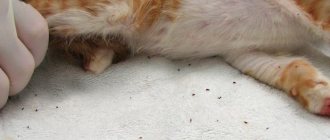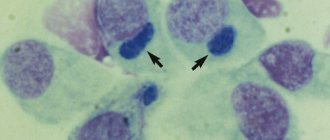How can an animal get burned?
In addition to tragic situations, such as a fire, a cat can suffer from a burn for simple, trivial reasons.
A pet that gets too playful can lose control and get scalded on a heating device; a cat can also easily knock over a pot of soup, a frying pan with oil, etc. Young cats need to sharpen their teeth, sometimes during birth they come across live wires under their paws, as a result - electric shock and electrical burn. Cats are curious creatures. Therefore, try to hide possible sources of burns from them. Of course, loving owners take all measures to prevent accidents, but, unfortunately, we are not able to foresee all the dangers. What to do if your cat gets burned?
In this article we will not talk about the treatment of burns, but about first aid, or pre-medical aid. Because in all cases of burns, except for the mildest ones, the cat needs to be examined by a doctor who can provide the necessary assistance and recommend subsequent treatment.
Types and causes of burns
Among the injuries, veterinarians distinguish the following:
- External. These include burning of the skin on various parts of the body.
- Internal. The brain and visceral organs are affected.
Damages also vary depending on the cause of their occurrence. Types and provoking factors:
Household chemicals are potentially dangerous for pets.
- Chemical burn. It occurs due to exposure of aggressive chemicals to the skin or body of a cat - alkaline or acidic solutions, organic substances (phenols), bleach. A cat receives such damage if it accidentally spills or drinks household chemicals on itself.
- Thermal burn in a cat. It develops under the influence of high temperatures on the skin if the cat steps on the surface of an iron or heating device, jumps on a hot stove, or stays near an open fire, especially while wearing flammable clothing. Sometimes the owner accidentally pours boiling water on the pet if it gets underfoot in the kitchen.
- Electric. It occurs when a cat accidentally steps on a wire with damaged insulation or has a habit of playing and biting wires.
- Solar. It affects hairless cats if the animal has been in the sun for a long time without protective clothing.
- Burn of internal organs. The structures of the respiratory or digestive system are most often affected. Occur due to inhalation of combustion products, toxic gases or ingestion of chemicals. The tongue, larynx, esophagus, and stomach are affected.
- Eye damage. Occurs due to chemicals entering the eye structures. These are various household aerosols, insect poison, gas.
Electrical shock burns
Such burns most often occur when a cat chews an electrical wire while playing. The consequences of electric shock in a cat are severe burns, swelling of the larynx and lungs. When providing first aid, it is necessary to turn off the electricity and remove the cat from the source of electric shock. If you do not know how to turn off the electricity, or do not have the opportunity to do this, then drag the cat away with a wooden stick or a broom (not metal).
If possible, immediately call an emergency veterinarian and follow their recommendations. If this is not possible, then treat the cat’s burns with a weak solution of furatsilin or potassium permanganate. Then, wrap the victim in something warm and immediately take her to the doctor. Only he can prevent or relieve swelling and treat burns in a cat.
Thermal burns
Of course, not all of our pets are raised correctly, so unpleasant situations can often arise due to their excessive curiosity. Such burns in a cat occur when exposed to hot steam, boiling water, hot oil or direct open flame. A particularly dangerous place is the kitchen, because this is where cats most often get burned, trying, no matter what, to steal the treat they like.
Some cats are practically fearless, and no matter how much they are chased, they are still drawn either to a pot of boiling water or to the fire. The result is a serious burn on the cat due to the fact that it singed its fur or knocked over a container of hot liquid on itself.
Chemical burns
Chemical burns in cats usually occur when acids, concentrated cleaning agents, or alkalis come into contact with the mucous membranes and skin.
These are rare, but the most severe types of burns. In case of a chemical burn on a cat, wash the affected area with water. Then it is necessary to establish what kind of substance the cat was burned with. This is necessary to neutralize the chemical. If it is determined that the substance is acidic, then it can be neutralized with an alkaline solution (for example, wash a cat’s burn with water and soda). In case of damage by alkalis, they can be neutralized with a vinegar solution. The next step is treatment with an antiseptic (potassium permanganate, furatsilin, chlorhexidine). Chemical burns are very painful and will require pain relief. Therefore, show the cat to the doctor as soon as possible.
This type of burn most affects hairless cats or animals with sparse, short hair. If you notice inflammation of the skin at the ends of the ears, bald patches, and possibly small sores, your cat most likely has radiation or sunburn.
For treating affected areas, products such as Eplan and Safroderm have proven themselves to be effective. Usually they are enough for treatment, and there is no need to contact a veterinarian. But even such an easy solution to the problem does not mean that you can’t keep an eye on your hairless cat. A little more sunshine and a lot of trouble can't be avoided.
Prevention of burns in cats.
Although cats love to be in the kitchen while cooking because they can't resist the wonderful smells that accompany the process, don't let your cat lie near the stove while you're cooking because a pot of boiling water or hot oil can easily be knocked over. Use rear burners whenever possible. Do not allow your cat to jump on tables, as she may jump onto a hot stove and get burned.
Although cats do not light fires, do not stick their fingers into sockets like small children, do not operate an iron, and do not cook on a gas or electric stove, they often suffer from the phenomenon that in humans is associated mainly with the above factors - from burns. As a rule, they arise due to electrical (electric shock), chemical, or thermal effects. By the way, the severity of a thermal burn, or as it is also called, a thermal burn, is very easy to underestimate, since it is significantly different from similar burns in humans.
Why are burns dangerous for a cat?
Healthy skin is a barrier that protects the animal’s body from environmental influences. The burned area loses its protective function - the risk of infection entering through the burn increases. In addition, this:
- pain;
- discomfort;
- disability.
If the burn covers a large area of the body - more than 15%, then there is no good prognosis for recovery; you will have to fight for your pet. If a cat's burn exceeds 50% of the total body area, then the animal will most likely die.
In addition to the skin, the pet can burn the oral cavity (electric shock when biting through wiring) and the upper respiratory tract (inhalation of acid steam, hot smoke). These types of burns not only bring significant discomfort to pets, they are actually life-threatening. For example, an animal may develop swelling of the respiratory tract due to a burn. As a result, the pet will no longer receive enough oxygen and will die as a result.
How dangerous are burns?
Healthy skin is a barrier between the body and the environment. It protects against infection and excessive fluid loss. Burnt skin loses its protective properties, so there is a risk of developing severe infectious complications, sepsis. Among other things, burns mean pain, discomfort, and restriction of movement.
If less than 15% of the body surface is damaged, then the prognosis for recovery is good; patients with burns of more than 50% of the body surface have a poor prognosis and high mortality.
In addition to skin burns, animals can have burns to the oral cavity - for example, from chewing electrical wires and electric shock, and burns to the upper respiratory tract (for example, from inhaling smoke from a fire). Burns to the mouth can cause severe discomfort and make eating temporarily impossible. Burns to the respiratory tract can be fatal because they lead to swelling of the respiratory tract, which prevents the animal from taking a full breath.
How to recognize a burn?
External damage
If the animal’s condition is caused by sun activity, then a characteristic dermatosis appears on its skin. When exposed to chemical solutions, the animal feels severe pain, rushes about, screams, and the skin or mucous membranes turn red. Electrical trauma is manifested by swelling of the upper respiratory organs, difficulty breathing, paralysis of the paws, and impaired cardiac and brain activity. When the eyes are burned, there is lacrimation, swelling of the eyelids, and the cat squints unnaturally. With solar dermatosis, peeling and erythema appear. If a cat burns its paw, body, or accidentally gets boiling water on it, veterinarians distinguish 3 degrees of severity of damage, the symptoms of which are shown in the table:
| Degree | Signs |
| Lightweight | Severe pain |
| Redness of the burned area | |
| Swelling | |
| Minor hyperthermia | |
| The dark footpad becomes whitish, pink or white becomes dark pink or red. | |
| Average | Pain, hyperemia, swelling |
| The appearance of bubbles with clear liquid | |
| Formation of crusts after opening of the bubble and leakage of liquid | |
| Hair loss | |
| Fever, refusal to eat | |
| Heavy | The deep layers of the dermis are affected |
| Carbonization and tissue death | |
| Lack of fur, paws peel off and claws fall out | |
| Temperature increase | |
| Lethargy, apathy, lack of appetite | |
| Vomiting as the body's reaction to pain and intoxication | |
| Bacterial infection and death |
First degree burns
The animal in the affected area of the body experiences: swelling, redness, pain, and a local increase in temperature. Possible causes: cat burn by boiling water or water with a temperature above 60 C°, short contact with fire or a hot surface, sunburn.
- Cool the affected area with water or a metal (spoon). It is not recommended to use ice - too much temperature contrast can cause pain, tissue rejection, and cracking.
- Treat the burn with a weak solution of potassium permanganate.
- It is advisable to treat with anti-burn ointment - Panthenol, Traumeel, Rescuer. As a last resort, sunscreen or universal cosmetic cream without impurities, Vaseline, will do.
- After emergency treatment, purchase a product to prevent infection of burns and treat the skin 4-5 times a day.
- The skin should be dry, with or without a thin crust. If small blisters appear on the surface of the skin, fluid is oozing, there is an odor coming from the burn - infection has begun - contact your veterinarian.
- If it is not possible to show the animal to a veterinarian, use Sangel or its equivalent, sprinkle the wound with streptocide powder - your task is to dry and disinfect the wound.
Important! The affected surface with a first degree burn does not need to be bandaged - friction can aggravate the situation. If the cat is actively licking the wound, use a “collar” - the burn should be dry.
Second degree burns
The first degree, complicated by watery blisters, which over time burst and turn into crusts. With a large area of damage, general weakness, increased baseline body temperature, severe pain, and refusal to eat are observed. Possible causes: hot oil or fat, prolonged contact with fire, fire of fur, chemical burn of a cat with alkali or acid, walking on asphalt on hot days.
- Eliminate hot substance: Oil is washed off with water.
- Porridge, soup, etc. – quickly wipe off with a towel or rinse with water.
- Alkali - treat with saline solution with lemon juice or vinegar (5–7%).
- Acid - wash with soap foam, 2% solution of baking soda and water (1 teaspoon per 750 ml of water).
Important! Do not try to wipe away the alkali or acid with a napkin - this will only make the damage worse.
- Cool the affected area. Use ice wrapped in a bag and a thin cloth or keep the animal under running cold water for as long as possible, but no more than 20 minutes.
- Be sure to give an anesthetic injection, it is advisable to use drugs from the Ketanov-Ketolong group - they block the nerve nodes of the brain.
- Treat the burn with a solution of alcohol and saline or propolis solution, alcohol content no more than 5%. As an alternative, a solution of potassium permanganate (red).
- Treat with anti-burn agents, cover the wound with sterile gauze, bandage without tightening.
- Inject the anti-inflammatory drug for 5-7 days.
- Change the bandage daily; if the bandage dries out, soak it in Chlorhexidine.
If your cat's paws are burned and there are blisters on the pads, contact your veterinarian. Self-treatment will cause a lot of pain to your pet, and anti-burn medications can give the opposite result - the structure of the skin of the pads differs from the integument of the body. The most you can do yourself is to put your paws in cold water (in a jar) until the doctor arrives.
Third degree burns
The wounds are covered with charred crusts, within a few hours necrosis begins - rejection of dead tissue, there is an increase in body temperature, refusal to eat and drink, internal intoxication, acute pain - a critical condition.
First aid is similar to that for second degree burns, but the wound is not bandaged, but covered with clean gauze or a thin white cloth (the white color reflects UV rays). It is necessary to urgently take the animal to the doctor, possible complications are pain and burn shock, sepsis, dehydration. Depending on the degree of damage, a decision is made on how to treat a cat’s burn:
- Damage to less than 30% of the body - local treatment with ointments, antibiotic therapy, comprehensive support of the body, pain blockade.
- Damage to more than 50% of the body - the tactics described above, elimination of necrosis followed by plastic surgery or temporary implantation of surgical metal plates.
- A defeat of more than 80% means euthanasia under general anesthesia.
Internal burns of mucous membranes
Stitches, wounds, scratches and other injuries in cats are not treated with brilliant green. When licked, brilliant green affects the tongue, esophagus, and stomach - a chemical burn. If a cat has a burn from brilliant green, give the animal Enterosgel or any available absorbent and immediately contact a veterinarian.
Food burns cause a lot of discomfort, but most often, the epithelium is restored within 10–12 hours. The situation is much more serious if the pet died in a fire. In addition to inhalation of carcinogenic gases, burns of the mucous tract are observed.
A burn to the nasal mucosa in a cat is accompanied by sneezing with the release of mucus and soot, coughing, and shortness of breath. To understand how to treat a cat, you need to identify the depth of the lesion; as first aid, the animal is given a subcutaneous injection of an immunostimulant and an anesthetic drug. An old but proven method - intravenous administration of a veterinary aqueous solution of methylene blue with glucose - quickly restores hemoglobin levels, 0.10–0.15 ml per 1 kg of animal weight.
Signs of a burn to internal organs
With such an injury, the animal can breathe with its mouth open.
When toxic chemicals or flammable substances are ingested, as well as from electrical burns in animals, the mucous membranes of the mouth, throat, esophagus, stomach, and brain are affected. Therefore, depending on the cause of the damage, the following symptoms are observed:
- difficult and frequent breathing, sometimes with an open mouth;
- coughing or sneezing;
- impaired or absent swallowing function;
- vomiting blood;
- convulsions;
- paw paresis;
- severe pain, but the animal may remain silent due to pain shock;
- disturbance of heart rhythm and coordination of movements;
- fainting.
What to do if the cat gets burned?
First aid
If an animal receives a thermal injury, the owner can use Panthenol.
At home, the owner must be able to assist the pet, since the animal’s life depends on it. Depending on the type of burn injury, first aid is provided as follows:
- Thermal:
- Apply Panthenol to the burnt area.
- Apply a cold compress for 15 minutes.
- Apply a sterile bandage.
- Inject the drug "Ketolong".
- Chemical:
- Neutralize the acid with soda solution.
- Prevent the effect of alkali with a weak solution of vinegar.
- Treat the affected area with diluted potassium permanganate, Furacilin.
- Electric:
- Turn off the power supply.
- Pull the pet away with a wooden mop or broom without metal fasteners.
- Take him to the veterinary clinic immediately, as cardiac arrest is possible.
- Eye burn:
- Rinse the organ with cool running water.
- Apply a sterile bandage to the eye.
- Solar:
- Keep your cat away from direct ultraviolet rays.
- Apply sunscreen with titanium dioxide.
Drug treatment
The animal can be given only those drugs that the doctor has selected for it.
All medications are prescribed by a veterinarian; it is prohibited to treat your cat yourself at home. Thermal burns of a cat's paw pads or other parts of the body can be cured with veterinary medications from the following groups:
- antibiotics;
- steroid medications;
- wound healing liniments;
- painkillers;
- anti-inflammatory.
For solar dermatitis, when the ears and natural bald spots near them are burned, retinoids, vitamin A, and P-carotene are used for treatment. For eye burns, bactericidal, decongestant and anti-inflammatory drugs are prescribed to prevent secondary infection. It is recommended to wear a sterile bandage, blanket or protective collar until the injuries heal.
Surgical intervention
If an animal's limbs are severely damaged, they are removed.
The operation must be done if the animal has a terminal stage of thermal burn. Dead tissue is removed; in severe cases, amputation of the damaged limb is performed. If the burn provokes laryngeal stenosis, a tracheostomy is performed, in which a T-shaped tube is installed in the trachea. Sometimes oxygen therapy sessions are required or the animal is connected to a ventilator. If the cat has burned the mucous membranes of the mouth and throat, after intensive therapy the cat should be fed through a tube or intravenously.
Treatment of burns in cats.
After the veterinarian determines the severity of the burns, treatment is prescribed. This may include periodic wound cleaning, dressing and antibiotic treatment. More severe cases may require intravenous fluids, steroids, antibiotics, and pain relievers. In cases where constant care is necessary to save your pet's life, hospitalization of the cat may be necessary. If the burns are extensive, skin grafts may be necessary to save the cat.
Kittens that frequently bite through electrical cords may have burns in their mouths that require antibiotics during treatment to prevent infection. Anti-inflammatory drugs are used to reduce swelling. If the electric shock causes lung damage, intensive care, including oxygen, is required to save life.
Treatment of a burn in a cat: first aid and aftercare
Having discovered a burn on a cat, you should not fall into a state of panic - you need to act quickly, but confidently and calmly. Emergency assistance has the following goals: relieve pain shock, prevent dehydration, carry out initial treatment of the burned area with disinfectants and prevent the spread of infection. To do this, it is recommended to take the following actions:
- Apply a cold water or ice compress to the affected area for no more than 20 minutes. For these purposes, you can use a cloth moistened with water, frozen food in a bag and other available means. If the burn is caused by hot food or other substances coming into contact with the skin, the remaining substance should be washed off under running water before applying a compress.
- Treat the affected area with a weak solution of potassium permanganate and apply anti-burn or bactericidal ointment.
- Apply a loose, non-tightening gauze bandage to prevent the cat from licking the injured area and causing infection. Dressings should be changed daily.
How to treat a cat’s burn in each specific case, as well as what medications to use, can only be determined by a veterinarian, so the owner’s main task is to alleviate the animal’s suffering, provide primary care, and promptly transport it to a veterinary clinic.
Classification of burns in cats
A burn in a cat, depending on the lesion, is divided into 3 degrees:
- A small area is damaged, where swelling and redness are visible. The animal experiences pain, discomfort, and body temperature is elevated.
- Symptoms similar to the first degree are more pronounced. Also on the burned area there are liquid-filled blisters, after damage to which crusts form. The pet feels weakness and pain, loses appetite, and the body temperature remains consistently high.
- There are open wounds on the skin with burnt edges. After a short period of time, tissue necrosis begins. The condition is accompanied by severe pain, high fever, and general intoxication of the body. The cat feels unwell and may lose consciousness.
Depending on the type of damage they are divided into:
- thermal, for example, from hot liquids or heating elements:
- electrical in case of electric shock;
- chemical, due to aggressive substances in household chemicals, as well as a burn on a cat from brilliant green applied over an open wound.
The danger of such an injury for a cat is associated with the loss of the protective function of the skin. Bacteria, viruses or infections freely penetrate into open tissues, causing more dangerous diseases. The prognosis for a cat’s recovery directly depends on the volume of affected skin:
- When the affected area of the body occupies less than 15% of the surface, the cat is able to recover and completely return to a healthy state.
- With a burn that occupies from 15% to 50% of the body, the prognosis for recovery is less rosy. A pet can only be cured with regular, long-term care from the owner.
- A cat that has been injured over 50% of its body has virtually no chance of surviving.
In addition to the skin, damage can affect the mouth, esophagus or nasopharynx. A burn to the upper respiratory tract causes severe swelling, which prevents the cat from receiving a normal amount of oxygen. In this case, the animal may even die.
What will the doctor do?
The veterinarian knows a lot. He knows not only what to apply to a cat’s paw if it’s burned, but also what product is best to use in each specific situation. In general, the scope of its capabilities is much wider. For example, a veterinarian is a first aid professional. He is accustomed to removing fur and dead tissue; few cat lovers are capable of this with such composure, due to skills.
Among other things, the veterinarian can immediately determine the extent of the damage, which makes it possible to immediately begin treatment of the animal.
If a cat has a burn to its mouth, it may lose the ability to feed. In this case, the doctor will feed the animal by injection or through a nasogastric tube.
Even with complex burns of the respiratory tract due to swelling, a tracheostomy may be necessary - an operation in which the doctor will make a hole in the trachea for breathing.
Other diseases How to treat a burn in a cat
It would seem, how can a cat get burned? In fact, there are many reasons for this. Because of their curiosity, cats often suffer by biting wires, receiving electric shocks, spilling hot water on themselves, or stepping on household appliances that operate at high temperatures. In any case, you will have to treat the animal, so in this article you will learn not only the basic methods of getting rid of sores, but also their varieties, since the method of treatment depends on the severity of the burn.
The type of burn depends on the severity of the injury:
• The first degree is the easiest to treat. It is accompanied by damage to the upper layers of the skin. Externally, the damaged area appears red, and when pressing on it, the cat experiences quite severe pain. Such injuries resolve on their own and therefore do not require any treatment; • With 2nd degree burns, the skin is damaged more deeply, causing the pet’s pain to become much more acute. At the burn site, small blisters are formed, filled with serous fluid inside. It is strictly forbidden to open them, since this symptom is a signal that it is time to take your pet to a professional veterinarian; • 3rd and 4th degree burns are the most complex and terrible, as they are often accompanied by complete damage to areas of the skin. In particularly serious cases, the injuries are so extensive that they damage not only the skin, but also the muscles and bones. Such an illness requires immediate contact with a veterinarian.
Since all burns, starting from the 2nd degree, require immediate medical attention, you should only know information on providing first aid to an animal. As mentioned above, stage 1 does not require medical intervention. You don’t even need to apply any ointments or antiseptics to the area. Cats tend to lick their injuries, so the open area should be covered with a special bandage that will protect the already irritated area from the cat’s rough tongue. This is especially important for severe 2-3 degree burns. Such injuries are simply covered with a napkin until you visit the clinic or until the doctor arrives. Some owners begin to panic when they see serious damage to their pet's skin. In fact, you need to pull yourself together immediately. Never try to do anything on your own, as there is a significant risk of worsening the situation. It is very important to cover the injury with a tissue to prevent the cat from licking the skin. This can lead to tissue separation and the opening of blisters with liquid, which will not only cause severe pain, but also additional injuries that will significantly prolong the animal’s recovery time from the burn. What does the doctor do at the stage of providing care? To begin with, he removes dead tissue and interfering fur, which can complicate the process of treating the wound. Depending on the severity of the burn, your pet may require different types of care, from routine antiseptic treatment to actual hospitalization. Veterinarians often perform skin grafting to stitch up an ulcer resulting from a burn. If a pet burns its mouth, a special catheter is inserted through which nutrients will flow. Sometimes a tracheostomy is done if a burn of the respiratory tract has been established. This type of injury is the most serious and dangerous. It is very important to provide timely assistance so that it does not become too late. In advance, protect your cats from objects that are potentially hazardous to the animal’s health.
Eye burns in cats
A cat can burn its eyes anywhere. This could be hot steam or a chemical found in eye drops. Regardless of the situation, the pet needs to come to the rescue - rinse the eyes with cold water. If the cat refuses to open his eyelids, he needs to be helped with his fingers, but without excessive force.
Burns on a cat are usually not as noticeable as on people, so owners cannot always objectively assess the extent of the damage and provide assistance appropriate to the injury. This is one of the main reasons why an injured cat should be examined by a doctor, even if it does not seem to be seriously injured. This can save not only the health, but also the life of the cat.
Chemical burn in a cat
Rarer in relation to thermal burns, but more severe, are chemical burns. An animal can get a chemical burn through close contact with caustic substances, usually household chemicals.
It is important to promptly rinse the affected area under running water and determine what substance caused the injury. This is important in order to identify the neutralizer. In case of acid damage, neutralization is carried out with alkaline solutions. For these purposes, at home, use a solution of baking soda mixed with water. If the burn is caused by alkalis, acetic acid is used as an emergency aid for neutralization. Next, treatment is carried out with antiseptic solutions.
Because chemical burns are extremely painful, it is important to numb the affected area. It is difficult to carry out pain relief at home, so it is recommended to seek help from a specialist veterinary clinic as soon as possible.
If the mucous membrane of the oral cavity or eyes is damaged, immediate first aid must be provided. Otherwise, complications cannot be avoided. An animal can get a burn to the mucous membrane of the eyes as a result of exposure to chemical or thermal factors - hot steam from a pan, substances included in medications.
As first aid, it is important to thoroughly rinse the animal's eyes or mouth with water using a syringe. The water must be cold. The owner of the animal cannot adequately assess the degree of damage, so it is recommended that in case of any violations, seek help from veterinary specialists.
Help with sunburn
Prolonged exposure to direct sunlight can cause a lot of harm to pets of hairless breeds, as well as white cats with short hair. The consequences of sunburn are:
- sore tips of the ears,
- bald areas,
- small sores.
In most cases, the help of a qualified veterinarian is not required. The effects of active exposure to ultraviolet rays can be eliminated within a few days. To do this, Saphroderm or Eplan are applied to the affected areas.
You should not endanger your beloved hairless pet. It is necessary to provide it with protection from direct sunlight.
Prevention
You should prohibit your pet from walking on a cold stove, otherwise he will think that it is safe and will also jump onto a hot one.
To prevent the cat from getting burned, it is important for the owner to take care of the safety of sockets and wires by checking the insulation and installing plugs. If the owner is preparing hot food, so that he does not spill on the pet, the cat should be locked in the room for a while. During house cleaning, you should remove the cat so that chemicals do not accidentally come into contact with it. It is recommended not to leave the cat in direct sunlight, especially from 12 to 17 hours.
Sources
- https://MyFavoritePet.ru/uhod-i-soderzhanie/ozhog-u-koshki.html
- https://InfoKotiki.ru/soderzhanie/pomosch/ozhog-u-koshki.html
- https://usatiki.ru/ozhogi-u-koshek/
- https://kot-kupon.ru/soderzhanie/ozhog-u-koshek-prichiny.html
- https://vashipitomcy.ru/publ/zdorove/bolezni/ozhog_u_koshki_vidy_stepeni_i_pomoshh/15-1-0-795
- https://www.PurinaOne.ru/cat/catmag/adoption-rescue/heat-burn
[collapse]
Scratches, wounds, cuts
Even the most minor scratches should be treated as similar wounds on humans are treated.
First of all, the wound must be washed with cool, clean water, and then the edges of the cut or scratch must be cauterized with hydrogen peroxide. It is important to remember that only the edges of the wound are treated; if you start pouring peroxide into the middle, the cat will be in great pain.
If the wound is more serious , then you will still have to take your pet to the veterinarian to have it stitched up. But before this, the damage still needs to be treated and bandaged.
If there are foreign objects (branches, glass) in the wound, do not try to remove them yourself. Your carelessness and lack of professionalism can only harm the animal.











